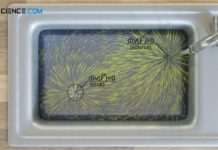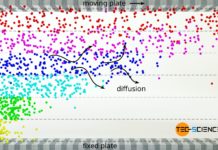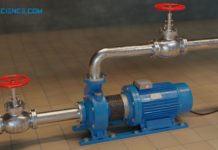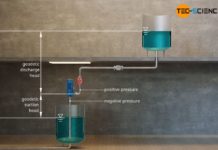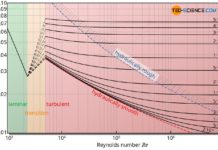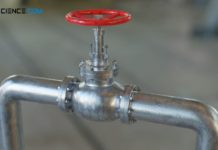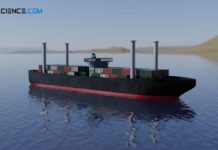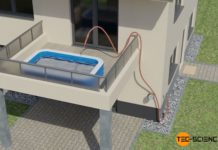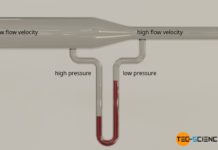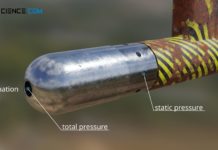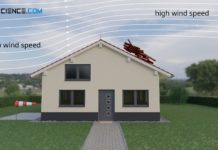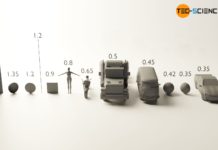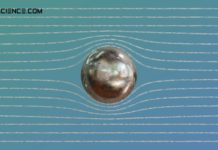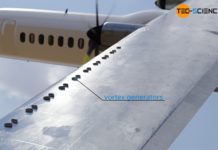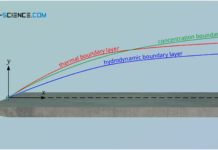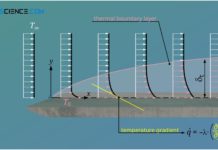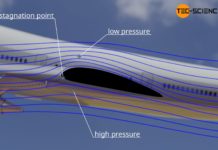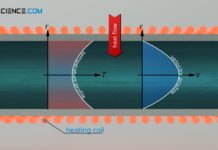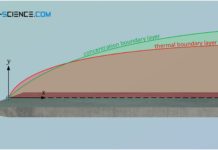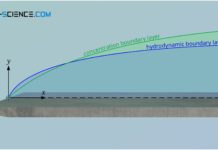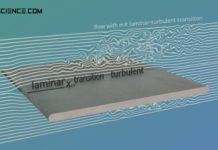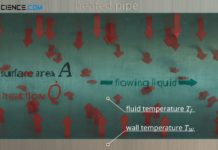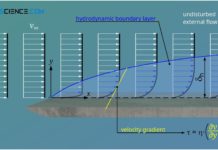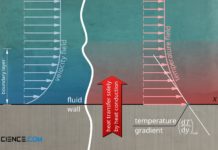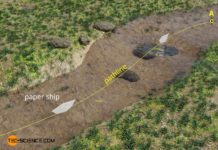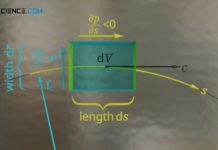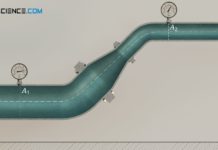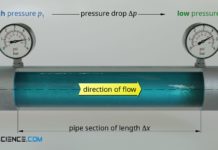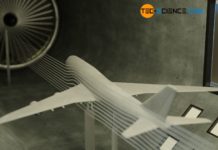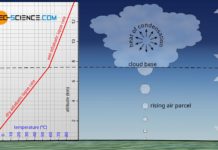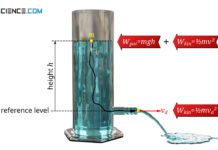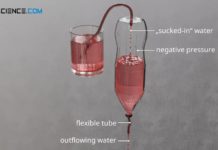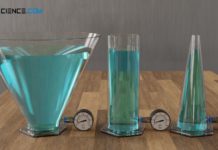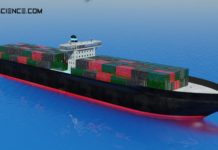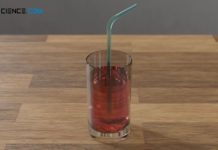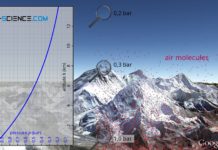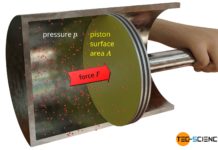Derivation of the continuity equation (conservation of mass)
In fluid mechanics, the equation for balancing mass flows and the associated change in density (conservation of mass) is called the continuity equation.
Continuity equation...
Viscosity of an ideal gas
The viscosity of ideal gases is mainly based on the momentum transfer due to diffusion between the fluid layers.
Definition of viscosity
In the article Viscosity,...
How does a centrifugal pump work?
Centrifugal pumps have a wide range of applications where the pressure increase is caused by centrifugal forces.
Radial, axial and mixed flow pumps
Centrifugal pumps are...
Pressure head and head loss
Learn more about the difference between elevation head, pressure head, friction head (head loss) and total static head of a piping system in this...
Moody chart (diagram)
The Moody diagram is a chart showing the Darcy friction factor of a pipe as a function of the Reynolds number for selected roughnesses...
Pressure loss in pipe systems (Darcy friction factor)
Pressure losses in pipes are caused by internal friction of the fluid (viscosity) and friction between fluid and wall. Pressure losses also occur in...
What ist the Magnus effect?
The Magnus effect refers to the lateral force acting on rotating round bodies in a flow!
Introduction
Anyone who has ever played football has most likely...
Exercises with solutions based on the Bernoulli equation
In this article exercises with solutions based on the Bernoulli equation are given.
Bernoulli equation
The Bernoulli equation is based on the conservation of energy of...
Venturi effect
The Venturi effect describes the decrease of (static) pressure in flowing fluids with increasing flow velocity due to a constricted section.
Pressure as volume specific...
What is a Prandtl tube and how does it work?
A Prandtl tube is used to measure the dynamic pressure. From this, the flow speed relative to the tube can be determined.
Stagnation pressure and...
Examples and applications of the Venturi effect
Learn more about examples and technical applications of the Venturi effect in this article.
Venturi effect
The Venturi effect (Bernoulli effect) refers to the decrease in...
Drag coefficient (friction and pressure drag)
Drag coefficients are dimensionless similarity parameters for describing the drag of flowed around bodies.
Parasitic drag (skin friction drag und pressure drag)
When a body moves...
Flow around spherical bodies (Stokes’ law of friction)
Stokes' law of friction describes the drag force acting on a spherical body around which a laminar flow passes.
Flow resistance and drag coefficient
When a...
Flow separation (boundary layer separation)
In the case of a boundary layer separation (flow separation), the flow can no longer follow the profile of the body around which it...
Dimensionless numbers of the boundary layers (Prandtl, Schmidt and Lewis number)
To describe the heat and mass transport, dimensionless numbers are introduced to describe the processes within the boundary layers.
Between a flowing fluid and a...
Thermal and concentration boundary layer
In addition to the hydrodynamic boundary layer, the thermal boundary layer and the concentration boundary layer also have a decisive influence on the entire...
Parasitic drag (skin friction drag & form/pressure drag)
Drag is the force of resistance that a moving body experiences in a fluid due to frictional and pressure forces.
Introduction
In the article on boundary...
Prandtl number
The Prandtl number is a dimensionless similarity parameter to describe the transport of heat and momentum.
Definition
In the article on the different boundary layers, the...
Lewis number
The Lewis number is a dimensionless similarity parameter to describe heat and mass transport.
The Lewis number always comes into play when a flowing fluid...
Schmidt number
The Schmidt-number is a dimensionless similarity parameter to describe transport of mass and momentum.
Not only the transport of momentum and the heat transfer influence...
Calculation of the Nusselt numbers for forced flows over plates and in pipes
In this article you will find formulas for calculating the local and average Nusselt numbers for forced flows over plates and in pipes with...
Heat transfer coefficient for thermal convection
The heat transfer coefficient describes the convective heat transfer from a solid to a flowing fluid and vice versa!
Introduction
The heat transfer coefficient describes the...
Hydrodynamic boundary layer
The hydrodynamic boundary layer of a flow has a decisive influence on heat and mass transport.
Introduction
In this article we take a closer look at...
Nusselt number to describe convective heat transfer
The Nusselt number is a dimensionless similarity parameter to describe convective heat transfer, independent of the size of the system.
Introduction
Convective heat transfer describes the...
Difference between streamlines, pathlines, streaklines and timelines
In order to make the flow of fluids "visible", one often uses the model of streamlines, pathlines (trajectories), streaklines or timelines.
Pathlines (trajectories)
Pathlines are flow...
Equation of motion of a fluid on a streamline
In this article we derive the equation of motion of a fluid element on a streamline and one perpendicular to it.
Introduction
In the following we...
Derivation of the Bernoulli equation
The Bernoulli equation describes the relationship between static, dynamic and hydrostatic pressure for inviscid and incompressible fluids.
Static, dynamic and hydrostatic pressure
Due to the pressure...
Derivation of Hagen-Poiseuille equation for pipe flows with friction
The Hagen-Poiseuille equation describes the parabolic velocity profile of frictional, laminar pipe flows of incompressible, Newtonian fluids.
Drive and resistance for flows
The flow of fluids...
Experimental determination of viscosity (viscometer)
Viscometry is the experimental determination of the viscosity of liquids and gases with so-called viscometers.
Definition of viscosity (Newton's law of fluid friction)
Viscosity describes the...
Energetic analysis of the Hagen-Poiseuille law
The Hagen-Poiseuille equation for describing the parabolic velocity profile of fluids in pipes applies only to long pipes for energy reasons!
Summary
As derived in detail...
Reynolds number (laminar and turbulent flow)
The Reynolds number is a dimensionless similarity parameter for describing a forced flow, e.g. whether it is an alminar or turbulent flow.
Laminar and turbulent...
Viscosity of liquids and gases
The viscosity of a fluid is a measure of the internal resistance to flow! It is caused by intermolecular forces and transport of momentum...
Derivation of the barometric formula (adiabatic atmosphere)
The barometric formula for an adiabatic atmosphere takes into account the decrease in temperature with increasing altitude and the associated effects on air pressure.
Barometric...
Discharge of liquids (Torricelli’s law)
Torricelli's law (Torricelli's theorem) states that the discharge velocity of a liquid equals a free fall of the liquid from the liquid surface to...
How does a hot air balloon work: Buoyancy in gases
Buoyant forces act not only in liquids but also in gases. This will be illustrated in the following by the example of a hot...
How does a hydraulic jack work: Pascals law
A hydraulic jack is based on Pascal's law, which states that the pressure in liquids acts equally in all directions.
Pascal's law
In the article Pressure...
Siphon
In this article, learn more about what a siphon is and how it works in practice.
Introduction
If, for example, you want to empty a pool...
Pressure in liquids (hydrostatic pressure)
The pressure at a certain depth of a liquid, which is caused by the weight of the liquid column above it, is referred to...
How do boats float: Buoyancy in liquids
Buoyancy is the force directed against gravity that an object experiences when submerged in a fluid (liquid or gas).
Indroduction
Everyone may have tried to lift...
Applications and examples of hydrostatic pressure
Learn more about applications and examples related to hydrostatic pressure in this article.
Hydrostatic pressure
In the article Pressure in liquids, the formation of hydrostatic pressure...
How does a drinking straw work?
Sucking creates a vacuum in the drinking straw, so that the greater ambient pressure pushes the beverage through the drinking straw.
Indroduction
Drinking out of a...
Derivation of the barometric formula (isothermal atmosphere)
The barometric formula describes the decrease of air pressure with increasing altitude.
Introduction
At sea level the atmospheric pressure is about 1 bar. However, practice shows...
Pressure in gases
The pressure of gases is caused on a microscopic level by collisions of the gas molecules with its container walls!
Introduction
Pressure p in the physcal...
Pressure
The pressure describes the force distribution on a surface and is therefore a measure of the magnitude with which a surface is loaded!
Definition
In everyday...

